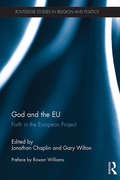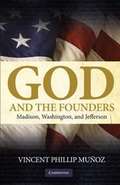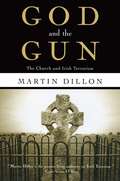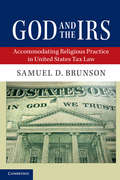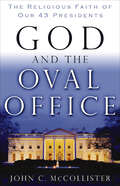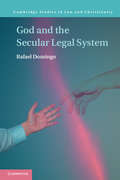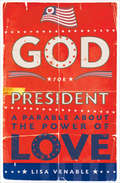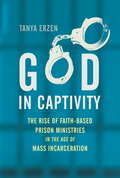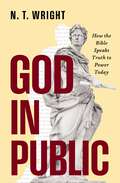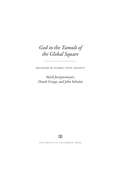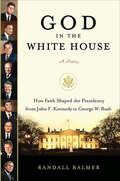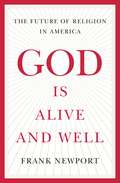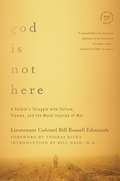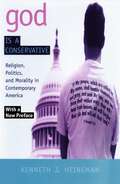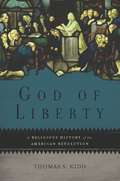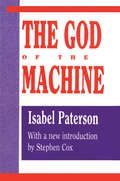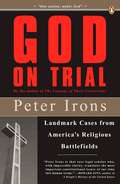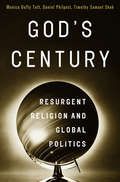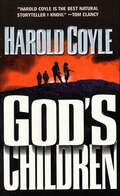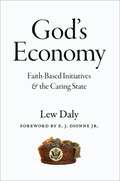- Table View
- List View
God and the EU: Retrieving the Christian Inspirations of the European Project (Routledge Studies In Religion And Politics Ser.)
by Jonathan Chaplin Gary WiltonThe current political, economic and financial crises facing the EU reveal a deeper cultural, indeed spiritual, malaise – a crisis in ‘the soul of Europe’. Many observers are concluding that the ‘soul of Europe’ cannot be restored to health without a new appreciation of the contribution of religion to its past and future, and especially that of its hugely important but widely neglected Christian heritage, which is alive today even amidst advancing European secularization. This book offers a fresh, constructive and critical understanding of Christian contributions to the origin and development of the EU from a variety of theological and national perspectives. It explains the Christian origins of the EU, documents the various ways in which it has been both affirmed and critiqued from diverse theological perspectives, offers expert, theologically-informed assessments of four illustrative policy areas of the EU (trade, finance, environment, science), and also reports on the place of religion in the EU, including how religious freedom is framed and how contemporary religious (including Muslim) actors relate to EU institutions and vice versa. The book fills a major gap in the current debate about the future of the European project and will be of interest to students and scholars of religion, politics and European studies.
God and the Founders
by Vincent Phillip MuñozDid the Founding Fathers intend to build a "wall of separation" between church and state? Are public Ten Commandments displays or the phrase "under God" in the Pledge of Allegiance consistent with the Founders' understandings of religious freedom? In God and the Founders, Dr. Vincent Phillip Muñoz answers these questions by providing new, comprehensive interpretations of James Madison, George Washington, and Thomas Jefferson. By analyzing Madison's, Washington's, and Jefferson's public documents, private writings, and political actions, Muñoz explains the Founders' competing church-state political philosophies. Muñoz explores how Madison, Washington, and Jefferson agreed and disagreed by showing how their different principles of religious freedom would decide the Supreme Court's most important First Amendment religion cases. God and the Founders answers the question, "What would the Founders do?" for the most pressing church-state issues of our time, including prayer in public schools, government support of religion, and legal burdens on individual's religious conscience.
God and the Gun: The Church and Irish Terrorism
by Martin DillonFirst Published in 1999. Routledge is an imprint of Taylor & Francis, an informa company.
God and the IRS: Accommodating Religious Practice In United States Tax Law
by Samuel D. BrunsonSeventy-five percent of Americans claim religious affiliation, which can impact their taxpaying responsibilities.<P> <P>In this illuminating book, Samuel D. Brunson describes the many problems and breakdowns that can occur when tax meets religion in the United States, and shows how the US government has too often responded to these issues in an unprincipled, ad hoc manner. God and the IRS offers a better framework to understand tax and religion. It should be read by scholars of religion and the law, policymakers, and individuals interested in understanding the implications of taxation on their religious practices.<P> Assembles stories of how tax accommodations function in today's world.<P> Provides a history of the development of tax law, religion clauses and tax accommodations.<P> Develops a framework to evaluate and design tax accommodations.
God and the Oval Office: The Religious Faith of Our 43 Presidents
by John C. McCollisterA look into how the temporary residents of the White House expressed the deepest of all human feelings—personal religious faith—in their own words.“We need to remember that the separation of church and state must never mean the separation of religious values from the lives of public servants.” —Lyndon B. Johnson“So help me God.” George Washington added those words to the presidential oath, and every president since has followed suit. Whether their faith was devout or doubted, heartfelt or pragmatic, John McCollister plumbs America’s strong and deep spiritual heritage, showing the fascinating and vital role faith played in the lives of each of our forty-three presidents:Thomas Jefferson’s “edited” version of the GospelsAbraham Lincoln’s unique approach to organized religionAndrew Johnson’s “secret” CatholicismJames Garfield’s personal sacrifice of the pulpit for the presidencyDwight Eisenhower’s trust in God’s sovereigntyRonald Reagan’s profound sense of forgivenessGeorge W. Bush’s unapologetic faith in Jesus ChristFrom George Washington to George W. Bush, most of our country’s chief executives have turned to God for assurance, guidance, and hope. Through what they learned in the Bible, bolstered by strength found in prayer, they have led America to become the greatest nation on earth. Timely and timeless, God and the Oval Office tells their story.
God and the Secular Legal System
by Rafael DomingoThis timely book offers a theistic approach to secular legal systems and demonstrates that these systems are neither agnostic nor atheist. Critical but succinct in its approach, this book focuses on an extensive range of liberal legal approaches to religious and moral issues and subjects them to critical scrutiny from a secular perspective. Expertly written by a leading scholar, the author offers a rare combination of profundity of ideas and simplicity of expression. It is a ringing defense of the theistic conception of secular legal systems and an uncompromising attack on the agnostic and atheist conception.
God for President: A Parable About the Power of Love
by Lisa VenableThe fate of the world is at stake, so God is running for president in Lisa Venable's delightful parable.Sarah Rose, a disillusioned American activist, has retreated from Washington politics to her hometown in Minnesota to work for a friend at the Heavenly Hair Salon. Sarah has essentially given up on God, but one day is provoked by a conversation between customers at the salon about the state of the world and she begins to wonder what God would do as president of the free world. Sarah exclaims, "Imagine it...people would think twice before they act. Laws would be made with love. The water would be clean again. The fighting and wars would cease. God would never allow these atrocities!"Out of nowhere, a mysterious, dazzling woman drops into Sarah's life and recruits her to help in a run for the Oval Office. Torn by her desire for a better world and her anger with U.S. politics, Sarah tries desperately to resist the woman's magnetism and call to help her country in the name of love.God for President offers a poignant reminder that listening to each other may get us farther along than shouting, that no one person or party may have the corner on "right" and "the American way."* A New Age parable for the new millennium - in the tradition of Jonathan Livingston Seagull or The Celestine Prophecy - about trusting the power of love.* Includes reader's discussion guide and suggested reading.
God in Action: How Faith in God Can Address the Challenges of the World
by Cardinal Francis George"What if God has his own ways that are not always our ways? What if God acts in public affairs in ways that can, of course, be ignored from day to day but at a price for individuals and whole societies? If God is an actor, how is it possible to trace his action? . . . Can we discover God's actions in the part of human experience that is public in our day?" --Francis Cardinal George In this bracing manifesto, His Eminence Francis Cardinal George, one of the leading Catholic intellectuals in America today, provides refreshing insight into the intersection of faith and the public sphere. Finding both challenges and reasons for hope, he lays out a vision for national life that respects natural law, human dignity, and the essential ways religion uniquely contributes to the common good. In our country today, the significance of religious faith is often reduced to personal spiritual convictions or peculiar ideas found within self-contained churches, synagogues, temples, and mosques. Yet, as Cardinal George argues, it is God acting through humanity that is the very root of the core ideals that shape society. In the process, a moral framework is built that allows life to flourish. Consequently, he calls for resistance to creeping ideas that seek to deny religious organizations the freedom to act on their convictions and, thus, shutting voices of faith out of the public square on culture-defining issues. Moreover, Cardinal George calls for a fundamental reevaluation of questions surrounding human rights, religious liberty, respect for life, just war, commerce, immigration, and globalization. In turn, he points out a clear path that respects individual conscience while integrating faith and natural law into the public conversation on our shared future. An important book for challenging times, God in Action presents a universal message rooted in the Catholic philosophical tradition that is impossible to ignore.From the Hardcover edition.
God in Captivity: The Rise of Faith-Based Prison Ministries in the Age of Mass Incarceration
by Tanya ErzenAn eye-opening account of how and why evangelical Christian ministries are flourishing in prisons across the United StatesIt is by now well known that the United States’ incarceration rate is the highest in the world. What is not broadly understood is how cash-strapped and overcrowded state and federal prisons are increasingly relying on religious organizations to provide educational and mental health services and to help maintain order. And these religious organizations are overwhelmingly run by nondenominational Protestant Christians who see prisoners as captive audiences.Some twenty thousand of these Evangelical Christian volunteers now run educational programs in over three hundred US prisons, jails, and detention centers. Prison seminary programs are flourishing in states as diverse as Texas and Tennessee, California and Illinois, and almost half of the federal prisons operate or are developing faith-based residential programs. Tanya Erzen gained inside access to many of these programs, spending time with prisoners, wardens, and members of faith-based ministries in six states, at both male and female penitentiaries, to better understand both the nature of these ministries and their effects. What she discovered raises questions about how these ministries and the people who live in prison grapple with the meaning of punishment and redemption, as well as what legal and ethical issues emerge when conservative Christians are the main and sometimes only outside forces in a prison system that no longer offers even the pretense of rehabilitation. Yet Erzen also shows how prison ministries make undeniably positive impacts on the lives of many prisoners: men and women who have no hope of ever leaving prison can achieve personal growth, a sense of community, and a degree of liberation within the confines of their cells.With both empathy and a critical eye, God in Captivity grapples with the questions of how faith-based programs serve the punitive regime of the prison, becoming a method of control behind bars even as prisoners use them as a lifeline for self-transformation and dignity.
God in Public: How the Bible Speaks Truth to Power Today
by N. T. WrightDrawing on a collection of lectures that N. T. Wright delivered from 1999 to 2015, God in Public brings together the message of Jesus--in its larger biblical context--and the challenges of the contemporary public and political worlds.In this book, Wright challenges the West's response to 9/11 and then expands to discuss a more Jesus-inspired way of approaching the public problems we find ourselves in, based on following Jesus' life and teachings.As Wright demonstrates the many ways in which faithful exegesis of scripture can throw fresh light--God's light--on the great philosophical and ethical problems of our day, he discusses urgent questions such as: What has Christianity to do with power?Why must the church remind those in authority of their responsibilities?What can Christians do to act as the voice of the voiceless?
God in the Tumult of the Global Square: Religion in Global Civil Society
by Mark Juergensmeyer Dinah Griego John SoboslaiHow is religion changing in the twenty-first century? In the global era, religion has leapt onto the world stage, though often in contradictory ways. Some religious activists are antagonistic and engage in protests, violent acts, and political challenges. Others are positive and help to shape an emerging transnational civil society. A new global religion may be in the making, providing a moral and spiritual basis for a worldwide community of concern about environmental issues, human rights, and international peace. God in the Tumult of the Global Square explores all of these directions, based on a five-year Luce Foundation project that involved religious leaders, scholars, and public figures in workshops held in Cairo, Moscow, Delhi, Shanghai, Buenos Aires, and Santa Barbara. In this book, the voices of these religious observers around the world express both the hopes and fears about new forms of religion in the global age.
God in the White House: A History
by Randall Herbert BalmerHow did we go from John F. Kennedy declaring that religion should play no role in the elections to Bush saying, "I believe that God wants me to be president"?Historian Randall Balmer takes us on a tour of presidential religiosity in the last half of the twentieth century—from Kennedy's 1960 speech that proposed an almost absolute wall between American political and religious life to the soft religiosity of Lyndon B. Johnson's Great Society; from Richard Nixon's manipulation of religion to fit his own needs to Gerald Ford's quiet stoicism; from Jimmy Carter's introduction of evangelicalism into the mainstream to Ronald Reagan's co-option of the same group; from Bill Clinton's covert way of turning religion into a non-issue to George W. Bush's overt Christian messages, Balmer reveals the role religion has played in the personal and political lives of these American presidents.Americans were once content to disregard religion as a criterion for voting, as in most of the modern presidential elections before Jimmy Carter.But today's voters have come to expect candidates to fully disclose their religious views and to deeply illustrate their personal relationship to the Almighty. God in the White House explores the paradox of Americans' expectation that presidents should simultaneously trumpet their religious views and relationship to God while supporting the separation of church and state. Balmer tells the story of the politicization of religion in the last half of the twentieth century, as well as the "religionization" of our politics. He reflects on the implications of this shift, which have reverberated in both our religious and political worlds, and offers a new lens through which to see not only these extraordinary individuals, but also our current political situation.
God is Alive and Well: The Future of Religion in America
by Frank NewportGallup Editor-in-Chief Frank Newport examines religion in America today, reviews just how powerfully intertwined religion is with every aspect of American society, and explores what appears to be religion’s vibrant future in the U.S. — all based on more than a million interviews conducted by Gallup since 2008.Popular books such as The God Delusion have dismissed religion as a delusional artifact of evolution and ancient superstitions. But should millions of Americans’ statements of belief and their behavior be dismissed that quickly? The pattern of religious influence in American society suggests mass consequence rather than mass delusion. In God Is Alive and Well, Frank Newport, Gallup’s Editor-in-Chief, provides a new evidence-based analysis of Americans’ religious beliefs and practices — and bold predictions about religion’s future in the U.S. Most Americans are at least marginally religious, significantly more so than in most developed nations around the world. The majority of Americans believe in God and say that religion is important in their daily lives. And Americans routinely participate in religious rituals. Levels of religious consciousness are not distributed equally. Systematic patterns of differences in religion occur with surprising regularity. An American’s religiosity is very much bound up with social position and geographic space. There is an important interplay between religion and life status factors — age, gender, marital status, having children — and with achieved status distinctions — class, education, income. Those who are most religious are demonstrably different across a wide spectrum of outcomes from those who are not. These include lifestyle choices, social participation, ideology, partisanship, and views on political and social issues. Religion can be the driver for highly disruptive social behaviors, up to and including the taking of human life. Unlike citizens of any other country in the world, Americans group themselves into hundreds of distinct micro religious groups and denominations. These groups are constantly evolving, splitting like amoeba to form new groups. The most common pattern today is the development of the “no name” religious group, consisting of Americans who worship only under the banner of their own nondenominational predilections. These religious groupings are sociologically related to social status, geography, politics, and social and political attitudes. The emotional, non-negotiable bases of religion and the nature of its appeal to the most ultimate of rationales mean that highly religious Americans are one of the most potentially influential groups in society. Religious beliefs provide a foundation for much of today’s American politics. America is and will remain a religious nation, and it is entirely possible that in many ways, religion will be more, rather than less, important in the years ahead. The foundation for God Is Alive and Well is the perspective of science — analyzing what people think, do, and believe about religion. Frank Newport’s distinction as a well-known social scientist and authority on American life, his media experience, and his unique personal history as the son of a Southern Baptist theologian will increase this book’s sales potential. God Is Alive and Well is based in large part on more than a million interviews Gallup has conducted in recent years — interviews that asked Americans about their religion, their religious beliefs, and their religious behavior. The resulting data provide an unparalleled and unprecedented database of information about Americans and their religions. Written for lay readers using a conversational tone, God Is Alive and Well presents new information with an entertaining style.
God is Not Here: A Soldier's Struggle with Torture, Trauma, and the Moral Injuries of War
by Thomas Ricks Bill Nash Lieutenant Colonel Edmonds George LoberGod Is Not Here is a powerful and intimate look into torture and its effect on both the tortured and the torturer. In May of 2005, the U.S. government finally acknowledged that the invasion of Iraq had spawned an insurgency. With that admission, training the Iraqi Forces suddenly became a strategic priority. Lt. Col. Bill Edmonds, then a Special Forces captain, was in the first group of "official" military advisors. He arrived in Mosul in the wake of Abu Ghraib, at the height of the insurgency, and in the midst of America's rapidly failing war strategy. Edmonds' job was to advise an Iraqi intelligence officer--to assist and temper his interrogations--but not give orders. But he wanted to be more than a wallflower, so he immersed himself in the experience, even learning Arabic. In a makeshift basement prison, over countless nights and predawn hours, Edmonds came to empathize with Iraqi rules: do what's necessary, do what works. After all, Americans and Iraqis were dying. Edmonds wanted to make a difference. Yet the longer he submerged himself in the worst of humanity, the more conflicted and disillusioned he became, slowly losing faith in everything and everyone. In the end, he lost himself. He returned home with no visible wounds, but on the inside he was different. He tried to forget--to soldier on--but memories from war never just fade away... In God Is Not Here, the weight of history is everywhere, but the focus is on a young man struggling to learn what is right when fighting wrong. Edmonds provides a disturbing and thought-provoking account of the morally ambiguous choices faced when living with and fighting within a foreign religion and culture, as well as the resulting psychological and spiritual impacts on a soldier. Transcending the genre of the traditional war memoir, Edmonds' eloquent recounting makes for one of the most insightful and moving books to emerge from America's long war against terrorism.
God is a Conservative: Religion, Politics, and Morality in Contemporary America
by Kenneth J. HeinemanFrom Billy Graham and Ronald Regan to Newt Gingrich and William Bennett, God is a Conservative provides an important look at the role of religion in conservative politics in modern America. Kenneth J. Heineman reveals the profoundly religious nature of contemporary conservatism, offering an intriguing look at the social history of moral politics over the last three decades, and the still tremulous aftershocks of the New Deal. With a new Preface that examines the Bush presidency, including a provocative analysis of his re-election, and the rising influence of the Conservative Right, God is a Conservative is essential reading for understanding today's American political landscape.
God of Liberty: A Religious History of the American Revolution
by Thomas S. KiddBefore the Revolutionary War, America was a nation divided by different faiths. But when the war for independence sparked in 1776, colonists united under the banner of religious freedom. Evangelical frontiersmen and Deist intellectuals set aside their differences to defend a belief they shared, the right to worship freely. Inspiring an unlikely but powerful alliance, it was the idea of religious liberty that brought the colonists together in the battle against British tyranny. In God of Liberty, historian Thomas S. Kidd argues that the improbable partnership of evangelicals and Deists saw America through the Revolutionary War, the ratification of the Constitution, and the election of Thomas Jefferson in 1800. A thought-provoking reminder of the crucial role religion played in the Revolutionary era, God of Liberty represents both a timely appeal for spiritual diversity and a groundbreaking excavation of how faith powered the American Revolution.
God of the Machine: God Of The Machine (Right Wing Individualist Tradition In America Ser.)
by Isabel PatersonThe God of the Machine presents an original theory of history and a bold defense of individualism as the source of moral and political progress. When it was published in 1943, Isabel Paterson's work provided fresh intellectual support for the endangered American belief in individual rights, limited government, and economic freedom. The crisis of today's collectivized nations would not have surprised Paterson; in The God of the Machine, she had explored the reasons for collectivism's failure. Her book placed her in the vanguard of the free-enterprise movement now sweeping the world.Paterson sees the individual creative mind as the dynamo of history, and respect for the individual's God-given rights as the precondition for the enormous release of energy that produced the modern world. She sees capitalist institutions as the machinery through which human energy works, and government as a device properly used merely to cut off power to activities that threaten personal liberty.Paterson applies her general theory to particular issues in contemporary life, such as education, .social welfare, and the causes of economic distress. She severely criticizes all but minimal application of government, including governmental interventions that most people have long taken for granted. The God of the Machine offers a challenging perspective on the continuing, worldwide debate about the nature of freedom, the uses of power, and the prospects of human betterment.Stephen Cox's substantial introduction to The God of the Machine is a comprehensive and enlightening account of Paterson's colorful life and work. He describes The God of the Machine as "not just theory, but rhapsody, satire, diatribe, poetic narrative." Paterson's work continues to be relevant because "it exposes the moral and practical failures of collectivism, failures that are now almost universally acknowledged but are still far from universally understo
God on Trial
by Peter IronsAn insightful and dramatic account of religious conflicts that keep America divided?from the acclaimed author of The Courage of Their Convictions As the United States has become increasingly conservative, both politically and socially, in recent years, the fight between the religious right and those advocating for the separation of church and state has only intensified. As he did in The Courage of Their Convictions, award-winning author and legal expert Peter Irons combines an approachable, journalistic narrative style with intimate first-person accounts from both sides of the conflict. Set against the backdrop of American history, politics, and law, God on Trial relates the stories of six recent cases in communities that have become battlefields in America?s growing religious wars.
God on Trial
by Peter IronsAn insightful and dramatic account of religious conflicts that keep America divided?from the acclaimed author of The Courage of Their Convictions As the United States has become increasingly conservative, both politically and socially, in recent years, the fight between the religious right and those advocating for the separation of church and state has only intensified. As he did in The Courage of Their Convictions, award-winning author and legal expert Peter Irons combines an approachable, journalistic narrative style with intimate first-person accounts from both sides of the conflict. Set against the backdrop of American history, politics, and law, God on Trial relates the stories of six recent cases in communities that have become battlefields in America?s growing religious wars.
God'S Empire
by Hilary M. CareyIn God's Empire, Hilary M. Carey charts Britain's nineteenth-century transformation from Protestant nation to free Christian empire through the history of the colonial missionary movement. This wide-ranging reassessment of the religious character of the second British empire provides a clear account of the promotional strategies of the major churches and church parties which worked to plant settler Christianity in British domains. Based on extensive use of original archival and rare published sources, the author explores major debates such as the relationship between religion and colonization, church-state relations, Irish Catholics in the empire, the impact of the Scottish Disruption on colonial Presbyterianism, competition between Evangelicals and other Anglicans in the colonies, and between British and American strands of Methodism in British North America.
God's Century: Resurgent Religion and Global Politics (The\norton Series In World Politics Ser.)
by Daniel Philpott Timothy Samuel Shah Monica Duffy ToftA fresh and illuminating perspective on the surge in religion's political influence across the globe. Is religion a force for good or evil in world politics? How much influence does it have? Despite predictions of its decline, religion has resurged in political influence across the globe, helped by the very forces that were supposed to bury it: democracy, globalization, and technology. And despite recent claims that religion is exclusively irrational and violent, its political influence is in fact diverse, sometimes promoting civil war and terrorism but at other times fostering democracy, reconciliation, and peace. Looking across the globe, the authors explain what generates these radically divergent behaviors. In a time when the public discussion of religion is overheated, these dynamic young scholars use deeply original analysis and sharp case studies to show us both how and why religion's influence on global politics is surging. Finally they offer concrete suggestions on how to both confront the challenges and take advantage of the opportunities posed by globally resurgent religion.
God's Children (Nathan Dixon #1)
by Harold Coyle“The modern master of life-under-combat [delivers] an engrossing, uncompromisingly suspenseful tale” of high-tech warfare (Kirkus Reviews).As the Good Book says, “Blessed are the Peace Keepers, for they will be called God’s Children.” Yet for American soldiers deployed to warzones on foreign soil, peacekeeping is not child’s play. In this action-filled technothriller, author and military expert Harold Coyle examines some of the most pressing issues facing today’s soldiers.When ethnic tensions in near-future Slovakia reach a boiling point, the US Army sends troops to join a NATO force in the region. God’s Children tells the story of 3rd Platoon, C Company, 2nd Battalion of the 13th Infantry, and two young officers who try to keep a peace that is falling apart before their very eyes.
God's Cold Warrior: The Life and Faith of John Foster Dulles (Library of Religious Biography (LRB))
by John D. WilseyWhen John Foster Dulles died in 1959, he was given the largest American state funeral since Franklin Delano Roosevelt&’s in 1945. President Eisenhower called Dulles—his longtime secretary of state—&“one of the truly great men of our time,&” and a few years later the new commercial airport outside Washington, DC, was christened the Dulles International Airport in his honor. His star has fallen significantly since that time, but his influence remains indelible—most especially regarding his role in bringing the worldview of American exceptionalism to the forefront of US foreign policy during the Cold War era, a worldview that has long outlived him. God&’s Cold Warrior recounts how Dulles&’s faith commitments from his Presbyterian upbringing found fertile soil in the anti-communist crusades of the mid-twentieth century. After attending the Oxford Ecumenical Church Conference in 1937, he wrote about his realization that &“the spirit of Christianity, of which I learned as a boy, was really that of which the world now stood in very great need, not merely to save souls, but to solve the practical problems of international affairs.&” Dulles believed that America was chosen by God to defend the freedom of all those vulnerable to the godless tyranny of communism, and he carried out this religious vision in every aspect of his diplomatic and political work. He was conspicuous among those US officials in the twentieth century that prominently combined their religious convictions and public service, making his life and faith key to understanding the interconnectedness of God and country in US foreign affairs.
God's Economy: Faith-based Initiatives and the Caring State
by Lew DalyPresident Obama has signaled a sharp break from many Bush Administration policies, but he remains committed to federal support for religious social service providers. Like George W. Bush's faith-based initiative, though, Obama's version of the policy has generated loud criticism--from both sides of the aisle--even as the communities that stand to benefit suffer through an ailing economy. God's Economy reveals that virtually all of the critics, as well as many supporters, have long misunderstood both the true implications of faith-based partnerships and their unique potential for advancing social justice. Unearthing the intellectual history of the faith-based initiative, Lew Daly locates its roots in the pluralist tradition of Europe's Christian democracies, in which the state shares sovereignty with social institutions. He argues that Catholic and Dutch Calvinist ideas played a crucial role in the evolution of this tradition, as churches across nineteenth-century Europe developed philosophical and legal defenses to protect their education and social programs against ascendant governments. Tracing the influence of this heritage on the past three decades of American social policy and church-state law, Daly finally untangles the radical beginnings of the faith-based initiative. In the process, he frees it from the narrow culture-war framework that has limited debate on the subject since Bush opened the White House Office for Faith-Based and Community Initiatives in 2001. A major contribution from an important new voice at the intersection of religion and politics, God's Economy points the way toward policy-making that combines strong social support with a new moral focus on the protection of families and communities.
God's Favorite: A Novel
by Lawrence WrightIn this fascinating work of historical fiction, Pulitzer Prize-winning author Lawrence Wright captures all the gripping drama and black humor of Panama during the final, nerve-racking days of its legendary dictator, Manuel Antonio Noriega.It is Christmas 1989, and Tony Noriega's demons are finally beginning to catch up with him. A former friend of President Bush, Fidel Castro, and Oliver North, this universally reviled strongman is on the run from the U.S. Congress, the Justice Department, the Colombian mob, and a host of political rivals. In his desperation, he seeks salvation from any and all quarters -- God, Satan, a voodoo priest, even the spirits of his murdered enemies. But with a million-dollar price on his head and 20,000 American soldiers on his trail, Noriega is fast running out of options. Drawn from a historical record more dramatic than even the most artful spy novel, God's Favorite is a riveting and darkly comic fictional account of the events that occurred in Panama from 1985 to the dictator's capture in 1989. With an award-winning journalist's eye for detail, Lawrence Wright leads the reader toward a dramatic face-off in the Vatican embassy, where Noriega confronts his psychological match in the papal nuncio.
